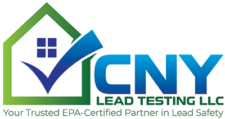Lead Paint Clearance Testing
A lead paint clearance test, conducted by the Environmental Protection Agency (EPA) or an EPA-certified lead-based paint inspector or risk assessor, is a critical component of the lead-based paint hazard control process. This test is typically performed after lead hazard reduction or abatement activities have been completed in a residential or child-occupied facility (such as a home, daycare, or school) that contains lead-based paint. The purpose of the clearance test is to ensure that the work performed to address lead hazards has been effective and that the area is safe for occupants, especially children, by verifying that lead levels are below specified standards.
Here are the key components and steps involved in an EPA lead paint clearance test:
- Qualified Inspector: The clearance test must be conducted by an EPA-certified lead-based paint inspector or risk assessor, ensuring that the person conducting the test is qualified to assess lead hazards.
- Visual Inspection: The inspector visually examines the area to ensure that all lead hazard reduction or abatement work has been completed as specified and that there is no visible dust, debris, or deteriorated paint.
- Dust Wipe Sampling: The primary method for assessing lead levels in the area is dust wipe sampling. The inspector collects dust wipe samples from specific locations, such as window sills, floors, and other surfaces that are likely to accumulate lead-contaminated dust.
- Laboratory Analysis: The collected dust wipe samples are sent to a qualified laboratory for analysis. The laboratory determines the lead content in the samples.
- Clearance Standards: The clearance standards set by the EPA or relevant state or local agencies must be met. These standards define the maximum allowable levels of lead in dust on various surfaces. If the lead levels exceed these standards, additional cleanup or remediation may be required.
- Documentation: The inspector documents the results of the clearance test, including the locations sampled, laboratory results, and whether the area meets the clearance standards. This information is typically included in a clearance report.
- Clearance Report: A formal clearance report is provided to the property owner or occupant. This report outlines the results of the clearance test and whether the area is considered safe for reoccupation.
- Occupancy: If the area passes the clearance test and meets the standards, it can be safely occupied. If it does not pass, additional cleanup or abatement work is necessary until the standards are met.
A successful lead paint clearance test is crucial in ensuring that a residential or child-occupied facility is safe from lead hazards after mitigation or abatement efforts. It provides peace of mind to occupants, particularly children and pregnant women, who are most vulnerable to the harmful effects of lead exposure. Property owners and managers should work closely with certified inspectors and follow all EPA and local regulations to ensure compliance with lead safety standards.
